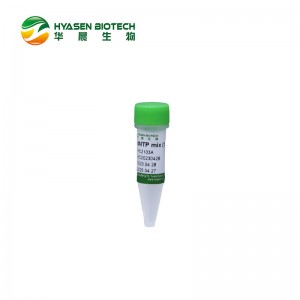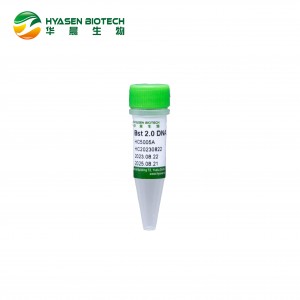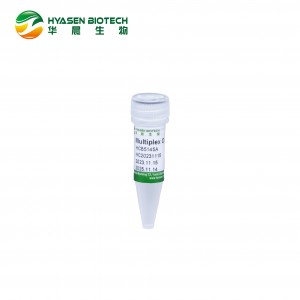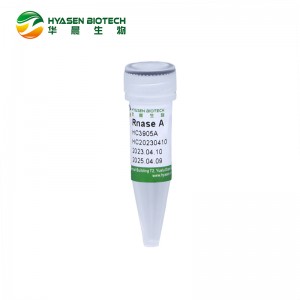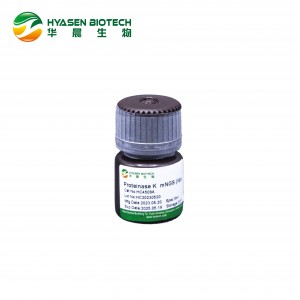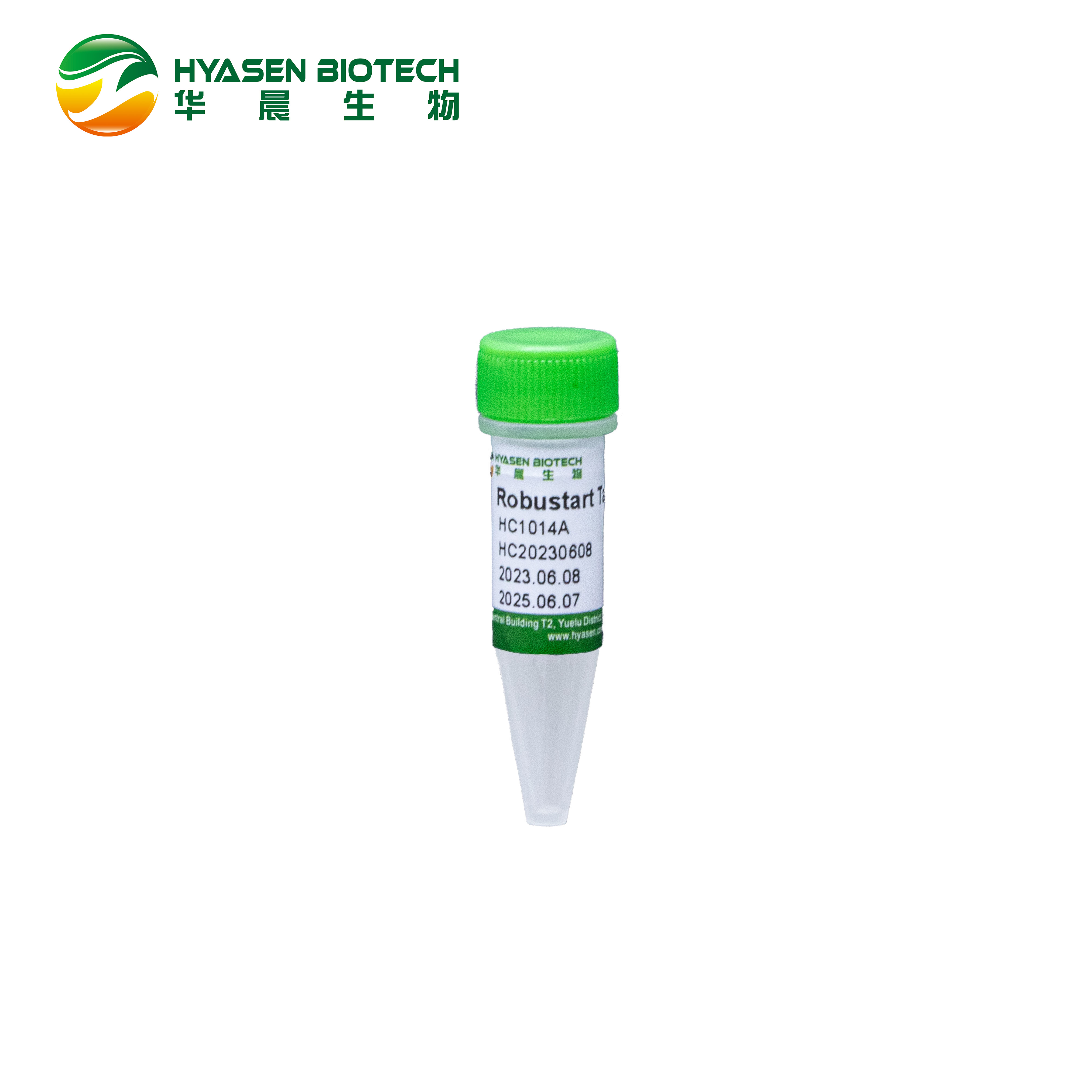
Hotstart Taq DNA Polymerase(lyophilized beads)
The Hotstart Taq DNA Polymerase Beads is a solid bead prepared from liquid Taq polymerase with uniform particle size. The PCR Buffer Mix contains MgCl2, a dNTP mixture, and an optimized reaction buffer. During the experiment, users only need to add the template and primers to perform the PCR amplification, which greatly simplifies pipetting operations, makes the procedure faster, and significantly reduces the risk of contamination during and after the PCR process. The Taq DNA Polymerase Bead features a hot-start function that activates the Taq DNA Polymerase at 90°C, reducing non-specific amplification. Additionally, the Taq DNA Polymerase Bead can be stored at room temperature (25 °C) and high humidity (>70%) for 6 months without significant loss of enzyme activity.
Components
|
Component |
Volume |
|
Hotstart Taq DNA Polymerase (lyophilized Beads) |
96T |
|
PCR Buffer Mix |
1 mL/tube |
Storage Condition
Transportation and storage at room temperature. 4°C is recommended for long-term storage.
Application
Suitable for conventional PCR amplification, fluorescence quantitative PCR detection (Taqman probe or dye)
Experimental Procedure
1. Conventional PCR Reaction System
|
Reagent Name |
Volume(μL) |
Final Concentration |
|
PCR Buffer Mix a |
10 μL |
1x |
|
Taq DNA Polymerase Hotstart Bead |
1 bead |
- |
|
Forward Primer (10 μM) |
0.5 μL |
0.2 μM |
|
Reverse Primer (10 μM) |
0.5 μL |
0.2 μM |
|
DNA template |
1-5 μL |
- |
|
ddH2O |
to 25 μLb |
- |
a. PCR Buffer Mix containing Mg2+ and dNTP, which are sufficient for the conventional PCR amplification reaction;
b.The reaction volume can be expanded to 50 μL, and the corresponding reagent component volume should be adjusted according to the expansion ratio.
1-1. Conventional PCR Reaction Procedures
|
Temperature (℃) |
Time |
Number of Cycles |
|
95℃ |
5 min (pre-denaturation) a |
1 |
|
95℃ |
10 S |
40~45 Cycles d |
|
58℃b |
30 S |
|
|
58℃ |
1 min |
1 |
|
10℃ |
Hold |
- |
a. The predenaturation time is suitable for most amplification reactions. If there is a complex structure in the template, the predenaturation time can be appropriately extended to improve the predenaturation effect;
b. The annealing temperature should be adjusted according to the primer Tm value, generally lower than the primer Tm value 3℃ ~ 5℃ . If there are templates with complex structure, it is necessary to adjust the annealing temperature and extend the extension time to achieve efficient amplification.
c. The extension time is adjusted according to the length of the template, and is generally set according to 30 sec/kb.
d. According to the purpose of the experiment, set the appropriate cycle number. Low number of cycles will cause insufficient expansion. High number of cycles lead to increase of the amplificons, but the mutation rate will also increase and cause non-specific amplification.
Fluorescence Quantitative PCR Reaction System
2.1 Taqman Probe Method
|
Reagent Name |
Volume(μL) |
Final Concentration |
|
PCR Buffer Mix |
10 μL |
1x |
|
Taq DNA Polymerase Hotstart Bead |
1 bead |
- |
|
Forward Primer (10μM) |
0.5 μL |
0.2 μM |
|
Reverse Primer (10μM) |
0.5 μL |
0.2 μM |
|
Taqman Probe (10μM) |
0.5 μL |
0.2 μM |
|
DNA template |
1-5 μL |
- |
|
ddH2O |
to 25 μL |
- |
a. The amount of each component in the fluorescent quantitative PCR reaction system can be appropriately adjusted according to the experimental requirements.
b. The final primer concentration is recommended to be adjusted between 0.1 and 1.0 μM, and 0.2 or 0.25 μM is recommended to achieve good amplification effect.
c. The Taqman probe final concentration is recommended to be adjusted between 50 and 250 nM, and the recommended concentration is 0.2 μM.
d.Fluorescence quantitative PCR is more sensitive. The template should be diluted before fluorescence quantitative PCR detection, and the specific dilution ratio should be based on the copy number of the template.
2.2 Dye method (taking SYBR Green I as an example)
|
Reagent Name |
Volume |
Final Concentration |
|
PCR Buffer Mix |
10 μL |
1x |
|
Taq DNA Polymerase Hotstart Bead |
1 bead |
- |
|
Forward Primer (10μM) |
0.5 μL |
0.2 μM |
|
Reverse Primer (10μM) |
0.5 μL |
0.2 μM |
|
SYBR Green I |
a |
0.2 ~ 1X |
|
DNA template |
1-5 μL |
- |
|
ddH2O |
to 25ul |
- |
a. Recommended SYBR Green I final concentration of 0.2 × ~ 1×.
Note: When the concentration of SYBR Green I is too low, the change of fluorescence signal will be reduced, and low-copy samples may not be detected. High concentrations will inhibit the PCR reaction, so the final concentration should be optimized according to the experiment. Improvement of the magnesium ions in the reaction system can reduce SYBR Green I inhibition of PCR. If the product of PCR Buffer Mix cannot meet the demand of experiment, can raise the magnesium ion concentration to meet the demand of experiment. It is recommended to use SYBR Green I for fluorescent PCR reaction, and magnesium ion concentration should be 0.5 ~ 3.0 mM higher than ordinary PCR reaction.
Fluorescence Quantitative PCR Reaction Procedures
|
Temperature (℃) |
Time |
Number of Cycles |
|
95℃ |
5 min(pre-denaturation) |
1 |
|
95℃ |
10 S |
40~45 Cycles c |
|
58℃ a |
30 S (fluorescence collection) b |
a.The annealing temperature should be adjusted according to the Tm value of the primer, generally 3℃~5℃ lower than the Tm value of the primer; If there are templates with complex structure, it is necessary to adjust the annealing temperature and extend the extension time to achieve efficient amplification.
b.The extension time is adjusted according to the length of the template, and is generally set according to 30 sec/kb.
c.This product is suitable for three-step PCR amplification program.
Product Features
1. Good particle diameter uniformity of Taq DNA Polymerase Hotstart Bead;
2. Hotstart Taq DNA Polymerase Hotstart Bead is convenient for storage and transportation, and esay-to-use for experimental operation;
3. Moisture-resistant: the beads does not deliquesce in high humidity environments.
4. Hotstart function to solve the problem of non-specific amplification of enzyme at low temperature;
5. Reduce the operation error rate, flexible for the combination with other analysis.
Matters Needing Attention
1. Before using this product, ensure that the reagent is completely thawed and gently mix by inverting and shaking before use.
2. This product is intended for use by professional researchers only and is not to be used for clinical diagnosis or treatment, nor for food or drug applications.
3. For your health and safety, please wear a lab coat and disposable gloves while handling this product.






-300x300.jpg)
